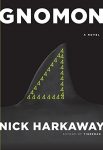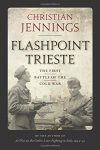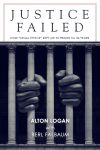|
|
Sometimes you must wonder if we’re on the verge of a surveillance state. There’s the NSA (and likely many others) closely watching electronic communications. Cameras intended to monitor traffic flow capture far more than that. Public and private places with camera surveillance are ubiquitous. The concern thus raises for individual privacy is a core of Nick Harkaway’s latest novel, Gnomon.
Harkaway envisions a near-future Great Britain in which an AI, the Witness, has access to total surveillance of the population and all information. It is a key to the System, a permanent direct democracy with ongoing polling and which allows citizens to vote directly on the country’s issues. As a “precautionary principle” to ensure the System keeps society the best it can be, it is occasionally necessary to investigate certain individuals via neurological access to their thoughts and memories. The subjects tend to emerge “happier, more organised and more productive” because the aftercare works like a “tune-up.”
 Now, for the first time, someone died during an examination — Diane Hunter, a nonconformist writer. Mielikki Neith, a die-hard inspector for the Witness, is called on to investigate what happened by accessing the recording of Hunter’s memories. But she discovers four additional personas in Hunter’s mind. They are Constantine, a Greek investment wizard; Athenais, an alchemist and the mother of St. Augustine’s son; Berihun Bekele, an Ethiopian artist who ends up doing the graphic design for the massively multiplayer online game (Witnessed)being created by his granddaughter’s company; and the title character, a future collective consciousness akin to the hive mind of Star Trek’s Borg. Now, for the first time, someone died during an examination — Diane Hunter, a nonconformist writer. Mielikki Neith, a die-hard inspector for the Witness, is called on to investigate what happened by accessing the recording of Hunter’s memories. But she discovers four additional personas in Hunter’s mind. They are Constantine, a Greek investment wizard; Athenais, an alchemist and the mother of St. Augustine’s son; Berihun Bekele, an Ethiopian artist who ends up doing the graphic design for the massively multiplayer online game (Witnessed)being created by his granddaughter’s company; and the title character, a future collective consciousness akin to the hive mind of Star Trek’s Borg.
As the book’s protagonist, Neith provides a framework police procedural story. Her investigation leads her to wonder if the System she believes in so fervently has an inherent defect or is perhaps even being manipulated. While intertwined with that framework, the other four characters create an esoteric labyrinth of mysticism and arcana somewhat reminiscent of Umberto Eco. Their stories unfold through a multitude of individual discourses as Neith reviews the recordings of Hunter’s interrogation. They are the novel’s ultimate failing.
Many of these chapters are confounding, almost impenetrable. They even occasionally take us into Hell and outside time. Several, especially Athenais’s, refer to so many mythological figures and ideas — with some early Christian history and symbolism thrown in — a reader is well-advised to have some sort of reference work handy. Harkaway’s word choices also call for reference material. He seems to prefer the obscure (“novacula, ”saccades,” ”pursuivants,” “apocatastasis”) over the straightforward.
Finally, many of these discourses are too lengthy and digressive. Gnomon clocks in at 700 pages. Granted, the story is complex, but it would have benefited greatly had several hundred pages been eliminated. As a result, I’m guessing a significant number of readers who start the book will not see it through to completion.
The universe has cancer.
Nick Harkaway,Gnomon
From time to time, history books present a stumbling block for readers. Some written by historians, particularly academics, read like they were — well — written by a historian. It’s not just writing style. There’s also that pattern of an opening chapter or introduction telling us what each subsequent chapter talks about, with each subsequent chapter opening with an overview of the chapter and closing with a summary of it.
That certainly isn’t the case with Christian Jennings’s Flashpoint Trieste: The First Battle of the Cold War. It reflects the beauty of concise, expositional writing. As a foreign correspondent, Jennings writes more like a journalist. This enables him to give the book a pace often lacking in more academic books. At the same time, though, he too often uses sentence fragments such as, for example,”Which had included what was now Yugoslavia.”
 Flashpoint Trieste tells a story of World War II and its aftermath not widely known. The city, located on the Adriatic, was annexed to Italy after World War I but Yugoslavians believed it should be part of their country. As World War II came to a close, British and American leaders feared that Tito being a communist could mean Trieste could end up essentially controlled by Stalin. This led to what was essentially a race to be the first to take the city as the war came to a close. Flashpoint Trieste tells a story of World War II and its aftermath not widely known. The city, located on the Adriatic, was annexed to Italy after World War I but Yugoslavians believed it should be part of their country. As World War II came to a close, British and American leaders feared that Tito being a communist could mean Trieste could end up essentially controlled by Stalin. This led to what was essentially a race to be the first to take the city as the war came to a close.
Ultimately, this meant the city was a geopolitical focus of the U.S., Great Britain, Italy, Yugoslavia and the Soviet Union. Flashpoint Trieste examines not only the interests and actions of each but also the history of the region, the ethnic tensions and bloody reprisal, and the melange of intelligence forces and operations.
While interesting, the book suffers from the antithesis of the problems that can arise in academia. While very readable, it seems to lack the rigor, continuity and depth of historical method. Jennings certainly shouldn’t be condemned for not being a professional historian. Yet in a genre with authors like Candice Millard, Ron Chernow and Hampton Sides, for example, Flashpoint Trieste requires more.
The actual status of Trieste can be determined at leisure. Possession is nine points of the law.
Winston Churchill to Harry Truman, quoted in
Christian Jennings, Flashpoint Trieste
Interesting Reading in the Interweb Tubez
- “No Fatties”: When Health Care Hurts (“According to the National Association to Advance Fat Acceptance, one out of three doctors responds to obesity negatively and associates it with poor hygiene, hostility, dishonesty, and noncompliance, viewing fat patients as ‘lazy, lacking in self-control, non-compliant, unintelligent, weak-willed and dishonest.'”)
- Trump Is the New ________ (“Once in front of the camera … historian-heavyweights trade in … scholarship for trivia-minded TV punditry. They hawk banality. Quizzed by anchors, boxed into panels, these academics have become cable contestants in a game of History-wood Squares.”)
- Is There Any Hope for the Future? (“We must accept that any subjective religion, philosophy, or opinion can’t be a basis for defining what is true.”)
Blog Headline of the Week
Bookish Linkage
Nonbookish Linkage
Men feared witches and burnt women. It is the function of speech to free men from the bondage of irrational fears.
Justice Louise J. Brandeis (concurring), Whitney v. California (1927)
Interesting Reading in the Interweb Tubez
Blog Headline of the Week
Bookish Linkage
Nonbookish Linkage
Reading the news and it sure looks bad
They won’t give peace a chance
That was just a dream some of us had
Joni Mitchell, “California,” Blue
I know from experience that attorney-client privilege plays a big role in a lawyer’s professional life. There’s plenty of times when a client or potential client wanted assurance that I couldn’t tell anyone else what they told me (with limited exceptions). The confidentiality of information is such an important ethical obligation that the American Bar Association calls it a “fundamental principle” of the relationship between attorney and client. But Alton Logan can tell you that the duty can cause problems. After all, when two lawyers adhered to their ethical obligation, Logan was incarcerated for 26 years for a murder he didn’t commit.
Logan tells his story in Justice Failed: How “Legal Ethics” Kept Me in Prison for 26 Years. And while Logan’s case epitomizes close to the worst dilemma attorney-client privilege might create, it is also a devastating commentary on ongoing problems in the criminal justice system. In a lengthy introduction, the journalist who collaborated with Logan on the book, Berl Falbaum, makes clear that he views the lawyers’ action show the law and the legal system are immoral. Yet the bulk of the book, written from Logan’s standpoint, is a fairly straightforward narrative of his life, one in which he appears much more understanding of what happened.
How Logan was ensnared by legal ethics is readily explained. He was arrested for the January 1982 murder of a security guard at a Chicago McDonald’s four blocks from his home. Age 28 at the time, Logan faced the death penalty. He was initially convicted in February 1983, the jury sparing him the death penalty by just two votes. Yet just a week after Logan’s arrest, Andrew Wilson, who actually shot the guard, was arrested for murdering two Chicago police officers. Less than six weeks after Logan’s arrest — and nearly a year before his trial — Wilson told his two public defenders that he’d killed the McDonald’s guard.
 Wilson’s refusal to disclose that himself or to let his attorneys do so put the attorneys in a Catch-22. Not only could revealing this information mean Wilson likely would have another capital murder charge, it could be used as an aggravating circumstance for the death penalty in the killing of the two officers. On the other hand, the attorneys knew an innocent man not only was in jail for a crime he didn’t commit, he too faced the death penalty. Their solution? They prepared and signed an affidavit saying “privileged sources” informed them that Logan was “in fact not responsible” for the McDonald’s shooting. Wilson’s refusal to disclose that himself or to let his attorneys do so put the attorneys in a Catch-22. Not only could revealing this information mean Wilson likely would have another capital murder charge, it could be used as an aggravating circumstance for the death penalty in the killing of the two officers. On the other hand, the attorneys knew an innocent man not only was in jail for a crime he didn’t commit, he too faced the death penalty. Their solution? They prepared and signed an affidavit saying “privileged sources” informed them that Logan was “in fact not responsible” for the McDonald’s shooting.
Fortunately for Logan, they also obtained Wilson’s permission to disclose the information after Wilson’s death, which they did in 2008. Still, the affidavit sat in a locked strongbox under the bed of one of the lawyers for 26 years. And, interestingly, the lawyers disagreed on whether they would have revealed the information if Logan had been sentenced to death.
Yet Logan’s conviction also involves police and prosecutorial misconduct. The biggest example is when police found the two guns used to kill the police officers. That search, just six days after Logan’s arrest, the also turned up a sawed-off shotgun. Ballistics tests revealed the shotgun fired a cartridge shell found at the McDonald’s murder scene. The police did not investigate the connection between Wilson and the shotgun. Then, at Logan’s first trial, the state convinced the judge that the shotgun and shell shouldn’t be admitted into evidence. Although an appeals court ordered Logan retried because of that, prosecutors managed to keep out evidence that it was Wilson who’d possessed the gun. Without that context, the jury had no reason to doubt the claim that Logan was the killer.
Logan and Falbaum both contribute to telling Logan’s story. Falbaum’s introduction delves into attorney-client privilege overall, its effect on the case, the frequency of prosecutorial and police misconduct, and resulting wrongful convictions. Perhaps because of this division of labor he is much more critical of the confidentiality rule. For example, he points out that one exception to attorney-client privilege includes a dispute over legal fees. That means, he says, lawyers can “violate” confidentiality to collect a fee “but not when an innocent person is facing execution or serving a life sentence in prison.” (While another exception allows disclosure when necessary “to prevent reasonably certain death or substantial bodily harm,” it didn’t apply. When the attorneys gained the information the guard’s death had already occurred and Logan’s death was not “reasonably certain” because no one knew if he would get the death penalty.)
Logan, in contrast, tells us the story of his life and his experience. In so doing, he comes off as far more reasonable about what happened than one might expect. Although at times guilty of a bit of repetition, Logan’s account is thoughtful and gives insight into what many criminal defendants, particularly those of color, experience. Yet this double barreled approach weakens the book.
While the authors may have felt an introduction to the issues was necessary, it creates a situation in which Falbum’s argument comes before readers are fully familiar with Logan’s story. Additionally, while Falbaum spoke with a large number of people, including multiple lengthy interviews with the attorneys, their thoughts and comments aren’t really weaved into Logan’s story. Instead, they are largely confined to the introduction and footnotes in Logan’s narrative. There is also a distinct difference in style. Logan writes in plain, everyday language in contrast to the analytical tone and content of Falbaum’s introduction. And Logan may leave you scratching your head at times. For example, he says that when police first came to his home after the McDonald’s murder he assured his mother he didn’t have anything to do with it. He then writes that he was at home with his mother and two other trial witnesses, the night of the killing. If they were together when the murder occurred, why would Logan need to tell his mother he wasn’t involved?
Ultimately, though, regardless of whether a different route would have improved the book, Justice Failed is an intriguing look at critical legal issues of which the general public is unaware.
A life sentence is just as bad as a death sentence. With a life sentence, it just takes longer for you to die.
Alton Logan, Justice Failed
|
Disclaimer 
Additionally, some links on this blog go to Amazon.com. As an Amazon Associate I earn from qualifying purchases. There is no additional cost to you. Contact me You can e-mail me at prairieprogressive at gmaildotcom.
|
 Now, for the first time, someone died during an examination — Diane Hunter, a nonconformist writer. Mielikki Neith, a die-hard inspector for the Witness, is called on to investigate what happened by accessing the recording of Hunter’s memories. But she discovers four additional personas in Hunter’s mind. They are Constantine, a Greek investment wizard; Athenais, an alchemist and the mother of St. Augustine’s son; Berihun Bekele, an Ethiopian artist who ends up doing the graphic design for the massively multiplayer online game (Witnessed)being created by his granddaughter’s company; and the title character, a future collective consciousness akin to the hive mind of Star Trek’s Borg.
Now, for the first time, someone died during an examination — Diane Hunter, a nonconformist writer. Mielikki Neith, a die-hard inspector for the Witness, is called on to investigate what happened by accessing the recording of Hunter’s memories. But she discovers four additional personas in Hunter’s mind. They are Constantine, a Greek investment wizard; Athenais, an alchemist and the mother of St. Augustine’s son; Berihun Bekele, an Ethiopian artist who ends up doing the graphic design for the massively multiplayer online game (Witnessed)being created by his granddaughter’s company; and the title character, a future collective consciousness akin to the hive mind of Star Trek’s Borg.








